Facing fast, short pitched bowling can be incredibly intimidating. In my opinion, if you’ve played cricket for any reasonable amount of time, you’ll have definitely felt that intense nervousness before you walk out to bat. For me, it was part and parcel of the game. I never really seemed to get over it. I definitely wasn’t one of those people who could walk in to bat and keep their mind clear and their emotions under control. Like I said, that is common with a lot of players even though they may not like to admit it! But that nervous feeling was never more prominent than when there was a really fast bowler waiting to run in and bowl me my first ball. If you’re reading this and having flashbacks to times when you’ve had those same feelings, then this is probably a post you should read!
As a batsman, at all levels of the game, the first few overs are the most difficult to get through. When those first few overs consist of someone bowling high pace into your ribs and head area, it becomes even more difficult!
I’ve got good news for you! With a bit of hard work it is 100% possible to improve your ability to deal with short pitched bowling. In this post I’m going to do my best to give you some helpful technique based tips that you can use to prepare yourself to face the short ball, and also teach you certain ways that you can attack it to try to take the pressure off yourself and put it back on the bowler! Here goes…
Technique
The one thing you are definitely going to need if you want to play short pitched bowling better is a sound technique, and more specifically, an ability to play off the back foot.
First, I want you to think of any legendary batsman.
Got one?
I would be willing to place a bet that the batsman you just thought of had an extremely effective way of playing the short ball. This is mainly due to the fact that most batsmen who have trouble playing bouncers don’t last very long at the highest level of the game once the opposition starts to target them in this area!
Two players that really jump out to me when I think of great back foot techniques are Alastair Cook and Ricky Ponting. Both of these players absolutely dominated short pitched bowling at various points during their careers, sometimes to such a degree that bowlers would stop targeting them in this area altogether. In my opinion that is the highest level we can reach and something we should all aspire to as players. If you can take something that the bowler is using to try to intimidate you and turn it around and make them fearful of bowling that delivery, then you will know you have won the mental battle!
In order to break this post down I believe there are several aspects of your technique that impact your ability to play the fast bouncing ball well. These are: Keeping your eye on the ball, trigger movements, the inclusion of a forward press, rolling your wrists on contact with the ball and getting on top of the bounce. Now let’s dive down another level and examine these in more depth:
Keep Your Eyes on the Ball
Obviously this is an aspect of batting technique that is applicable to all players, of all ages, facing all styles of bowler. It really is that important! But it definitely takes on even greater importance when facing short pitched bowling, not only because it helps us to make better decisions and connect with the ball more accurately, but also because it helps to keep us safe.
I like to refer to advice given by professional players who have dominated the international game in my posts as they know what it takes to succeed at the highest level. I really appreciated the way Kevin Pietersen referred to this aspect of his technique in an interview he did a while back. He refers to it as ‘kissing the ball’, (not literally of course) but simply trying to get the head as close to the ball as comfortably possible whilst keeping your eyes trained upon it.
Although facing bouncers can definitely be scary, one of the worst things you could possibly do is to shut your eyes and/or stop tracking the flight of the ball. This makes us more susceptible to top edging the ball and being out caught, mistiming the shot, and also being struck on the body. A perfect example to follow is the one set by Matt Prior in the photo below. The ball is mere milliseconds away from making contact with his bat but still his eyes are wide and watching the ball all the way through its flight.
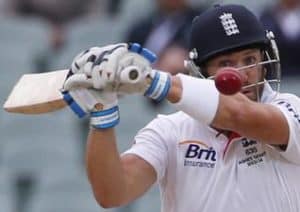
When batting, wherever your head and eyes go, the rest of your body follows! Therefore, it really is vital that we concentrate on watching (or kissing) the ball in our practise sessions so that it becomes second nature to us.
Trigger Movements
Ok, before I start talking about the advantages of having a trigger move, I need to lay out some of my thoughts. Firstly, I don’t think they are something that young batsmen playing junior level cricket need to really think about. Players at an early point in their cricketing careers shouldn’t be over complicating the game, and it is for this reason that I think you should wait until you are older and facing much faster bowlers before you think about developing this side of your game. Once you begin playing for senior teams, having a trigger move can be an effective way for you to buy time against the faster more intimidating bowlers.
Secondly, I’m a firm believer that it is very hard to copy the trigger of another player. Although it is likely that we will take inspiration from some of the professional batsmen and look to emulate them, our trigger movement will often end up changing somewhat and becoming unique depending on what is comfortable for us. Another key point to remember is that any trigger movement that you develop must allow you to have your head and eyes level and as still as possible as the ball leaves the bowlers hand. In my opinion this is the most critical thing about batting!
So what exactly is a trigger movement? And how can they help?
A trigger movement is something that helps us get our body in the best position to play the ball, and usually involves a slight adjustment in the position of the feet prior to the ball leaving the bowlers hand. When watching cricket on the TV, you may sometimes hear commentators refer to something called a ‘back and across movement’. What they are referring to is a movement made by the batsman before the ball has been bowled that takes him back in his crease, and slightly across to the off stump. The theory is that these movements allows us to get our feet moving early before the bowler has delivered the ball, and create a base from which we can play a front or back foot shot relatively easily. As batsmen, we can then choose to whether to strike or leave a bouncer, but its vital that we are balanced and set up to play the initial shot.
Some batsmen such as Steve Smith of Australia have larger trigger moves, which involve moving from leg stump right over to the off stump, whereas batsmen like Sachin Tendulkar have no trigger move at all, and prefer to remain totally still at the crease. To see this, go watch any video of these two players batting, and you’ll be able to see a noticeable difference. Prior to the bowler delivering the ball, Steve Smith will have moved across the crease quite significantly, whereas Sachin will have remained pretty stationary.
There are obviously advantages to both having a trigger move and choosing to remain still at the crease. Therefore it is important that every individual player must test these out to work out what benefits them the most.
As I mentioned earlier in this section, this aspect of your technique mainly comes down to individual preference, so I will not go as far as to recommend one type of trigger move as being better than another. The main things to take away from this section are to ensure that any movements you do make allow your head and eyes to be level upon delivery of the ball, and that in order for trigger moves to start to feel natural they must be practised long and hard in the nets.
Forward Press
Before we start here I’d like to admit that yes, the forward press does tie in to the previous section covering trigger moves, as I am trying to emphasise a movement that should occur before the bowler has delivered the ball. However, here I am going to try to emphasise the positives that come with a forwards movement rather than anything else.
Over the years I’ve tried to pick up as many tips as I can from watching various professional player masterclasses and interviews. One of the most common pieces of advice that the top players have when it comes to facing short pitched bowling is that the batsman should look to attack more often than not and try to be positive, rather than retreat into their shell.
Take Kevin Pietersen for example, one of the most aggressive players of the modern era. He says that no matter who he was facing, his predominant movement would always be forwards towards the bowler. This ensures that his front knee is bent and his weight is over that front knee. If the bowler bowls a full ball, Pietersen is already in a great position to attack. If the bowler bowls a short ball, it is very easy to push back off your front foot and stand up tall to play a hook or pull shot. This is what we call the forward press! Pietersen rightly says that it is a lot easier to press forwards first and then go on to the back foot, than it is to start with your weight back and then come forward to drive at a full ball.
Put simply, batting is all about getting into great positions. If you’re expecting the short ball and are batting reluctantly with your weight slumped backwards, then it is going to be incredibly hard for you to hit full balls outside the off stump consistently well. Good bowlers will notice that you’re fearful of short pitched bowling due to your lack of forward foot movement, and then pitch the ball fuller, increasing your chances of edging the ball to the keeper/slips.
I’m a firm believer that if you have your weight slightly forwards over your front knee and are looking to be aggressive, it will allow you to maintain a lot more balance at the crease. Having that balanced base is the foundation from which you can play any shot, including ducking out of the way of the bouncers if you choose!
Perhaps the greatest example of why the forward press is a good approach to take comes in the form of words spoken by Virat Kohli, the current Indian national team superstar:-
“I think even to leave the ball on a bouncer, it is very important to want to hit the ball. If you are looking to leave the ball, your weight is already on the back foot and then you are in no position to leave or hit the ball. If you are looking to hit the ball, you take your body forwards and then you can be balanced enough to duck under it. I think that is one key aspect that a lot of people mistake.
If you are looking to leave the ball, then more often than not you will get hit on the glove or the helmet. If I am looking to hit the ball, then I can get under the ball much better, I have much better balance because my body is going forward. I have a good base to duck under the ball.”
I think these words from Kohli really emphasise the advantage of a positive approach to facing short pitched bowling, and how important it is to not let the thought of the being struck by the ball consume you. The forward press allows us to get in a position to play a number of different shots depending on what type of delivery is bowled, and that’s the reason I would always recommend practising this in the nets.
Getting on Top of the Bounce & Rolling the Wrists
When playing the hook or the pull shot to a short ball, there is always the risk that the ball will go up in the air, and if the captain of the other team is cunning enough, he will have a fielder placed close by to try and take advantage of this!
The best players of short pitched bowling reduce the risk of getting out by ‘getting on top of the bounce’ and rolling their wrists when the bat makes contact with the ball. ‘Getting on top of the bounce’ means that when playing the short ball you should be on the balls of your feet, and stood up as tall as you can to try and get your eyes above the level of the ball. This will make the shot much easier to control. Playing the short ball becomes much more dangerous when you lose sight of the ball above your eye line, as you are more susceptible to top edges and hitting the ball straight up in the air!
As for rolling your wrists, this is a relatively simple thing that can be added to your game, and it can make a huge difference. It helps you keep the ball down by turning the bat face over as you make contact with the ball.
To illustrate how this happens, first consider a shot where the batsman does not roll his wrists and the bat face comes through at the same angle throughout the entirety of the shot. The ball is going to leave the bat at whatever angle the bat face is tilted. This is perfectly illustrated in the photo below. In this photo, I have not rolled my wrists, and as a result the position of the bat would cause the ball to travel up in the air!
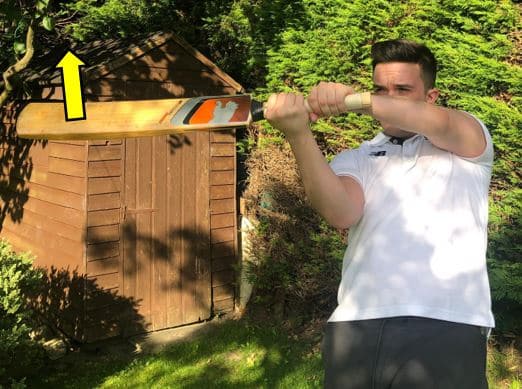
Now check out the next set of photos below and compare it to the one above. Note the positions of the bats face in both! In the photos below, I have ‘rolled’ my wrists so that the bat face is now in a downwards facing position at the end of the follow through. It’s really that simple, as you play the hook shot, practise turning the face of the bat slightly towards the ground. This imparts a downwards momentum to the ball and gives you the best chance of reducing the amount of time the ball is in the air.
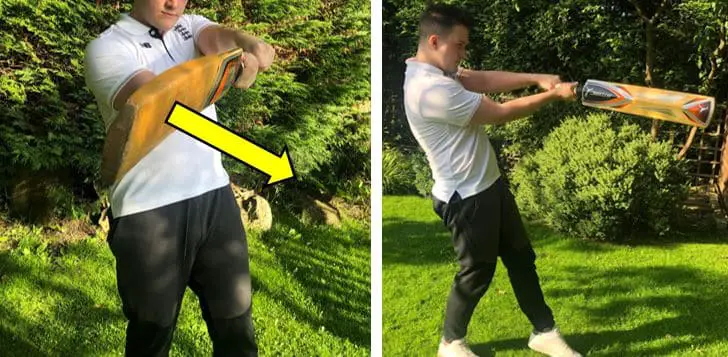
Of course, in cricket, there are always ways an opposition bowler/captain could use this to try to get you out. For example, placing a fielder much closer to the bat on the leg-side, but this would be a much harder catch to take than one on the boundary after a top-edge!
Mentality
I know from my own experience that the fear of receiving a spell of short pitched bowling from a fast bowler can often be very paralysing, and can cause a batsman to be a lot more reluctant to attack. Although this will happen to us all at some point, I believe it is so important to not allow the bouncer to dominate your mind, as this will lead to your front foot game being affected too.
This may sound like I’m stating the obvious here, but I believe this point is important. The only way you can get to a place where you feel mentally and physically comfortable when facing short pitched deliveries is by putting in some serious hours of practise. This helps to ingrain relevant visual cues in our heads. Examples of visual cues to look for when batting are how the ball leaves the bowlers hand and what length the ball pitches on. The more we experience this type of bowling in practise, the more we know what to look for in real game situations, and therefore our body will be more prepared to react quicker and more effectively to those visual cues as a result.
I remember Virat Kohli stating that ‘it is important to want to hit the short ball in order to get in a good position to do so’, and again, I believe that feeling of wanting to hit a short ball can only be brought about due to facing many hundreds and maybe even thousands of those deliveries in the nets to build up confidence.
The reality is, no batsman is going to be able to walk to the crease and remain composed and assured whilst receiving a short pitched onslaught from a bowler if he does not already have the sufficient muscle memory required to do so.
Gameplan
When facing a fast bowler, and specifically short pitched bowling it is very important to have a clear plan of what balls you are going to attack and where you are going to hit them, as well as which ones you are going to leave or defend and how you plan to do this. Top batsmen will often set this out in their heads when practising in the days before they play, focusing on things like leaving the ball if it pitches on a certain line or length. This is definitely a good thing for players like me and you to practice during our net sessions. Often, the more disciplined batsmen and the ones that are fully aware of their own strengths and weaknesses are the hardest to bowl at, as they won’t be dragged out of their comfort zone.
It is for that reason that we’re about to look at some of Ricky Ponting & Alastair Cooks preferences when facing the short ball. Both of these players have been tested against the fastest bowlers in the world and have come up with a few little rules they like to try to stick to. Let’s have a look…
Evasive Tactics
If the opposing captain has fielders patrolling the boundary on the leg-side waiting for you to pull or hook a ball straight to them, then you might want to think about leaving the short ball alone altogether. Obviously this depends how much of a naturally attacking player you are, as well as the situation of the game that you are playing in and how quickly you need to score runs, but being able to duck and leave the ball confidently is always a very useful skill to have.
Alastair Cook has a couple of very simple rules which makes it easier for him to leave the ball if he chooses to, and it all depends on the line of the ball. Basically it goes like this:
- If the line of the ball is more towards the leg-side of his body, he will look to duck underneath the ball, as swaying his head backwards would bring the head closer to the ball.
- If the line of the ball is towards the off-side of his body, he will look to sway his head and torso backwards towards the leg-side of the ball rather than duck under it. He can then watch the ball go past in front of his eyes. Ducking to a ball on this line could cause him to move his head closer to the ball than it needs to be and could therefore put him at risk of being hit.
I’ve used the diagram below to illustrate this approach. If I wanted to leave a short delivery that is to the left of the yellow line, I would try to sway out of the way. For deliveries to the right of the yellow line, I would simply duck down underneath the ball.
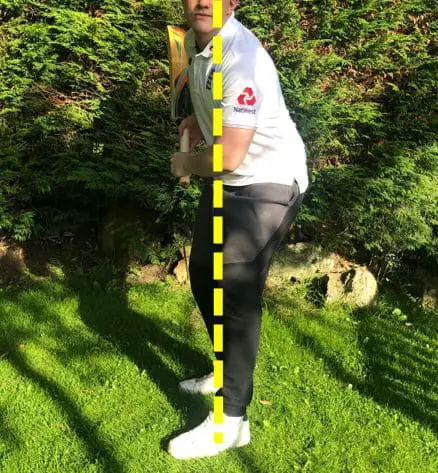
Don’t skip this section just yet guys! One final piece of advice to remember is that whenever you duck/sway out of the way of the bouncer, you should always try to move your hands well away from the ball. Batsmen regularly get out caught behind after getting hit on the gloves whilst trying to duck and therefore focusing on ‘dropping your hands’ is an excellent way to avoid that. Next time you’re practising against the short ball, try to focus on getting your hands as low as possible when leaving the ball, trust me; it’ll help you out in the future!
Attacking Options
As a batting side, your objective is to score runs and put the bowlers under pressure. Batsmen who play the short ball well are often incredibly good at transferring pressure on to the opposition by hitting the ball for boundaries, and therefore minimising the bowlers’ margin for error as a result.
The Standard Hook & Pull Shot
Of course your standard hook and pull shots are the most common way of being aggressive against this type of bowling, and both of these shots come with risk of being out caught, and getting hit by the ball. However, when used effectively they can also bring huge rewards. When playing these shots its vital that you as the batsman try to balance the risk and reward.
Both shots are cross bat shots played towards the leg-side, but the main difference between the hook and the pull is the height of the ball that has been bowled. Hook shots are played to balls that are shoulder to head height, whereas a pull shot would include anything above waist height up to shoulder height.
Before the bowler runs in to bowl, take a good look around at where the fielders are. If you see big open spaces on the leg-side boundary, then you know you have an open invitation to hit the hook or the pull. You can easily practice this in the nets! Focus on trying to hook and pull to different areas, try to hit some shots in the fine leg area, and some towards square leg. Once you become more confident with your placement on these shots, you will be able to pick the gaps in the field a lot easier when it comes to a real game situation.
I don’t think there are many things more exciting to watch in cricket than an extremely aggressive batsman going toe to toe with an express pace bowler, and seeing who comes out on top. Probably the finest example of this that I can remember is Kevin Pietersen vs Brett Lee at the Oval in the 2005 Ashes series. It was the classic case of the unstoppable force meeting the immovable object, with neither player willing to give an inch or be defeated. Lee bowled what must have been one of the most intimidating spells of short pitched bowling anyone had ever faced, and Pietersen hooked and pulled his way to 158 whilst saving England in this test. If you’ve never seen any highlights of the innings then I would definitely recommend watching some. It was one of the best bits of cricket I’ve ever seen.
Ponting’s Rules for Shot Selection
Similar to Alastair Cook’s rules for leaving the ball, Ricky Ponting has a couple of rules that he uses during matches to decide where and how he is going to try to hit the short ball. The rules are as follows:
- If the line of the ball is close to or on his body, then Ponting looks to hit the ball very fine on the leg-side. He believes that this type of ball doesn’t need to be hit as hard, and that he can simply get his head outside the line of the ball and use the pace that was generated by the bowler in order to ‘help the ball on its way’. Ponting also sees this type of delivery as one that can be easily pulled for 6, again due to the fact that it does not have to be hit as hard to get to leg-side boundary. A good rule to remember is that the straighter the short ball is, the less hard you have to hit it, it can simply be glanced around the corner.
- If the line of the ball is slightly more to the off-side of his body, then Ponting loved to launch into one of his favourite shots, the pull in front of square on the leg-side. Because the ball is outside the off stump and his desire is to strike it through the leg-side, then this is a shot that Ponting will look to hit a lot harder than the previous one. As this ball isn’t as straight, Ponting must generate a lot of his own pace on the ball.
The Uppercut
Another great option that modern players use to attack the short ball that is outside off stump is the uppercut shot. Whenever I speak about this shot I instinctively think of Sachin Tendulkar as he was one of the players who popularized it the most, especially in ODI’s! Check out the photo below if you want to see me trying to replicate his famous uppercut shot!
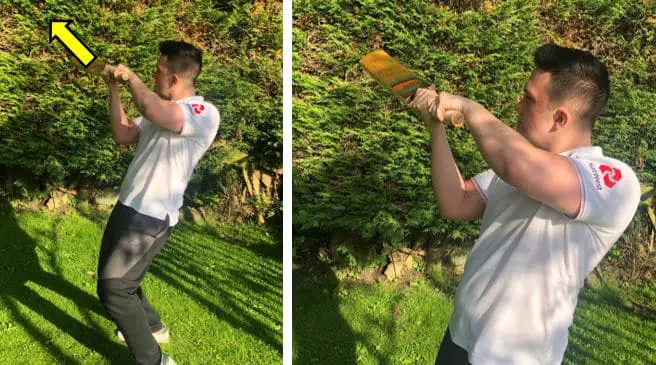
The main issue with this shot as a batsman is identifying the line of the ball. If the ball gets too close to your body then it can be very hard to free your arms up in order to direct the ball towards the off side. This can be combatted somewhat by leaning back as you play the shot. This gives you the space you need to get underneath the ball, space that you would not have if you remain standing perfectly upright. The key here is early identification of the line and length, and then remaining balanced while you execute the shot, keeping your eyes trained on the ball throughout.
The uppercut is usually played when the opposition captain does not have a third man fielder in place, and the intention is to hit the ball over the slip fielders for four or six. This is another shot where you can let the pace of the bowler be his own downfall by allowing the ball to just glance off the face of the bat. It really isn’t a shot that you have to hit hard in order to get boundaries.
Being able to hit short pitched bowling in this sort of area can be incredibly frustrating for the opposition. The hardest batsmen to bowl at are the ones that can hit the ball 360 degrees around the field, especially in the limited overs forms of the game. The uppercut shot lets the bowler know that if he doesn’t bowl a perfect bouncer, then you can dispatch him over the off-side as well as the leg-side with the hook and pull shots, making it very difficult to set a defensive field to. To learn more about other back foot shots that batsmen can play, you probably should read my detailed post on types of cricket shots. That post includes a lot of basic information on where the shots are hit, when they are played, as well as how to play them!
Adjust Your Position on the Crease
Some batsmen choose to move around the crease prior to the bowler delivering the ball, in the hope that it will unsettle him and disrupt his line and length. There are a healthy amount of bowlers that see a batsman moving around, and choose to try to follow them with the short ball. This can provide us with some excellent opportunities.
By backing away to the leg side, this would mean that any bouncer that was received would have a higher chance of being towards the off-side of the body. This allows us to free up our arms and play the uppercut or some other similar shot as mentioned in the previous section. Whether the ball is bowled short or not, in attacking situations making these movements can allow us to potentially create new scoring opportunities for ourselves, and also put doubt in the bowlers mind.
If all else fails…
I’d like to finish this post with a bit of advice that absolutely never fails. If you really want to be comfortable while there’s a fast bowler running in to bowl, the best way to do so is from the non-strikers end. Why not simply take a single, get off strike and watch someone else do all the hard work…
Also, if you want more high quality batting tips like these, then I’d recommend checking out my essential batting tips post by clicking here! Reading this will give you a good understanding of the things you have to do to be a successful batsman at the top level.
